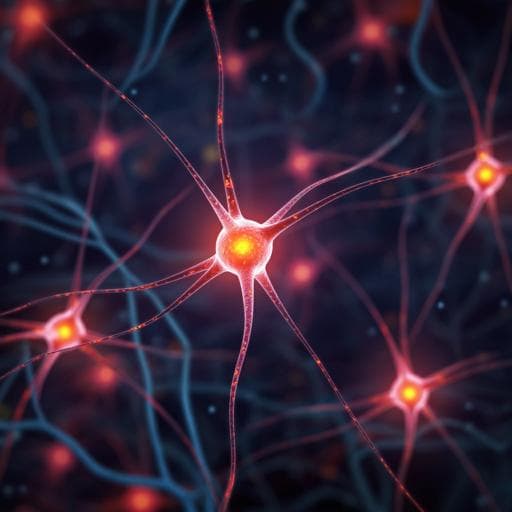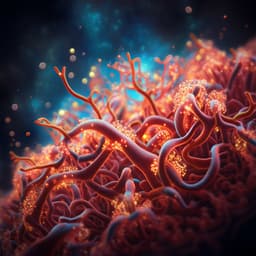
Biology
Adeno-associated viral vectors for functional intravenous gene transfer throughout the non-human primate brain
M. R. Chuapoco, N. C. Flytzanis, et al.
Discover how researchers, including Miguel R. Chuapoco and Nicholas C. Flytzanis, have tackled the challenge of crossing the blood-brain barrier in primates. Introducing AAV.CAP-Mac, a groundbreaking engineered virus that enhances gene delivery efficiency in the brain without invasive techniques. This innovative approach could revolutionize non-invasive gene transfer in animal studies.
~3 min • Beginner • English
Introduction
The study addresses a central challenge in CNS gene therapy: enabling efficient, safe, and non-invasive adeno-associated virus (AAV)-mediated gene delivery across the blood-brain barrier (BBB) in non-human primates (NHPs), particularly Old World primates (OWPs) that are closely related to humans. While engineered AAV variants such as AAV-PHP.B/eB enable robust BBB crossing in mice, these vectors largely fail to translate to NHPs, with AAV-PHP.B ineffective in rhesus macaques. Alternative routes (intrathecal, intra-cisterna magna) have limited brain efficacy and potential toxicity (for example, dorsal root ganglia pathology). High-dose systemic AAV delivery raises safety concerns, underscoring the need for more efficient vectors with improved therapeutic index. The authors aim to engineer and validate an AAV capsid variant, AAV.CAP-Mac, selected in primate species to enhance systemic BBB crossing and neuronal transduction in NHP brains, thereby expanding the toolbox for neuroscience and improving translational prospects for human therapies.
Literature Review
Prior work has evolved AAV capsids via CREATE and other strategies to cross the BBB and bias tropism to CNS cell types in mice (for example, AAV-PHP.B/eB), enabling widespread systemic delivery of tools such as GCaMP. However, these mouse-selected capsids often show strain dependence and do not translate to NHPs; notably, AAV-PHP.B fails to cross the BBB in rhesus macaque. In NHPs, direct intraparenchymal injection can be effective but is not amenable to brain-wide delivery. Intrathecal or intra-cisterna magna administration shows limited brain efficacy and has been linked to adverse pathology, particularly in the dorsal root ganglia. The heterogeneity of the BBB across species and mouse strain-specific receptor expression (for example, LY6A) contribute to poor cross-species translation. Recent efforts have started to engineer capsids in or for primates to improve translatability, but effective non-invasive systemic vectors for OWPs remain scarce.
Methodology
Capsid engineering and selection:
- Library design: An AAV9-based capsid library was generated by inserting seven NNK degenerate codons (7-mer) between VP1 amino acids Q588 and A589 (cap gene). First-round diversity yielded 33,314 unique amino acid variants recovered in adult marmoset brain.
- In vivo selection in marmoset: Two rounds of IV selections in adult common marmosets (2 × 10^12 vg per animal; two animals per round). After round 1, a synthetic oligo pool containing each recovered variant plus a codon-modified replicate (total 66,628 oligos) was used to produce the second-round library. High-performing variants were identified by NGS, enrichment scoring, and sequence clustering (Cytoscape). Two candidates were chosen: AAV.CAP-Mac and AAV.CAP-C2.
Pool testing in newborn rhesus macaques (OWP):
- Eight-capsid pool (AAV9, CAP-Mac, CAP-C2, and five engineered controls) each packaging ssCAG-hFXN-HA with a unique 3′UTR barcode. Dose: 1 × 10^14 vg kg^−1 total (1.25 × 10^13 vg kg^−1 per variant), IV via saphenous vein to two neonate macaques; tissue collected 4 weeks later.
- Assessments: HA immunostaining for protein expression; NGS-based barcode quantification from viral DNA and whole RNA to measure enrichment relative to AAV9 in brain and liver.
Single-vector characterization in infant OWPs:
- Newborn rhesus macaque: IV administration of a three-vector CAP-Mac cocktail (ssCAG-mNeonGreen, ssCAG-mRuby2, ssCAG-mTurquoise2) at 5 × 10^13 vg kg^−1 total; analysis 4 weeks post-injection. Cell-type tropism by co-staining with NeuN (neurons) and S100β (astrocytes). Also tested ICM administration (2.5 × 10^13 vg kg^−1) for comparison.
- Infant green monkeys (7–8 months): Single IV dose of either CAP-Mac or AAV9 packaging ssCAG-eGFP (7.5 × 10^13 vg kg^−1). Biodistribution by qPCR of vector genomes across 11 brain regions; tropism by NeuN and S100β co-labeling; non-brain tissue biodistribution and expression also assessed.
Cargo validation and functional assays:
- Mouse cargo screening: In adult mice, CAP-Mac was used via ICV and IV routes to evaluate neuronal tropism and to select GCaMP constructs (one-component vs two-component) for NHP experiments.
- Newborn rhesus macaque functional imaging: IV delivery of CAP-Mac/ssCAG-GCaMP8s (3 × 10^13 vg kg^−1). After 4–6 weeks, ex vivo two-photon imaging performed in hippocampus, thalamus, and cortex with field-potential stimulation; metrics included ΔF/F peak, rise/decay time constants, FWHM, and SNR.
Cultured human neuron transduction:
- iPSC-derived mature human neurons were transduced with CAP-Mac or AAV9 carrying ssCAG-eGFP across doses (10^1–10^6 vg per cell). Outcomes: EC50 for transduction efficiency and mean eGFP intensity in GFP+ cells (biphasic fit).
Adult rhesus macaque characterization:
- Ex vivo slices: Temporal cortex slices (300–400 μm) from a 14-year-old rhesus macaque cultured at air–liquid interface. Slices were exposed to AAV9 or CAP-Mac (1–2 μl at 5 × 10^13 vg ml^−1), packaging ssCAG-FXN-HA or ssCAG-eGFP; assessed at 8 days for DNA (vector genomes), RNA (transcripts), and cell-type tropism (NeuN colocalization).
- In vivo: Two adult rhesus macaques received the eight-capsid pool IV (7.5 × 10^13 vg kg^−1 total); recovered brain DNA was used for barcode enrichment analysis vs AAV9. Separately, one 17-year-old rhesus macaque received CAP-Mac/ssCAG-eGFP IV (1 × 10^13 vg kg^−1) to evaluate protein expression patterns (antibody-amplified GFP).
Adult common marmoset characterization:
- Two adults (3.8 and 5.8 years) received IV AAV9 or CAP-Mac (1 × 10^12 vg kg^−1). Brain sections analyzed for tropism; vasculature labeled with GLUT1 immunostaining; vector genomes quantified.
Molecular and computational analyses:
- Viral DNA and RNA extractions from tissues (TRIzol-based), barcode PCR, NGS on Illumina platforms. Library enrichment defined as log10(RCx,injected library/RCx,tissue) after filtering (≥100 reads, enrichment thresholds) and clustering by reverse Hamming distance.
- Quantitative PCR for vector genomes and transcripts (LightCycler II; TaqMan probe-based for eGFP and genomic reference; or SYBR Green in green monkeys). Imaging quantification with confocal microscopy, Cellpose/ImageJ for cell counts and co-localization.
Doses, routes, timelines:
- Neonate macaques: Pool IV 1 × 10^14 vg kg^−1; CAP-Mac XFP cocktail IV 5 × 10^13 vg kg^−1; CAP-Mac GCaMP8s IV 3 × 10^13 vg kg^−1; ICM 1.5 × 10^12 or 2.5 × 10^13 vg kg^−1.
- Green monkeys: CAP-Mac or AAV9 IV 7.5 × 10^13 vg kg^−1.
- Adult macaques: Pool IV 7.5 × 10^13 vg kg^−1; single-vector CAP-Mac-eGFP IV 1 × 10^13 vg kg^−1.
- Adult marmosets: CAP-Mac or AAV9 IV 1 × 10^12 vg kg^−1.
Ethics: All procedures approved by relevant IACUCs across Caltech, NIH/NIMH, UCSD, UC Davis CNPRC, Virscio, and Washington National Primate Research Center.
Key Findings
- CAP-Mac outperforms AAV9 in infant rhesus macaque pool testing: CAP-Mac barcode was 9× (DNA) and 6× (RNA) more abundant in brain vs AAV9; CAP-C2 ~4× enriched vs AAV9 (DNA and RNA). In liver, CAP-Mac and CAP-C2 were negatively enriched relative to AAV9.
- Newborn rhesus macaque IV single-vector CAP-Mac (5 × 10^13 vg kg^−1 total, 3 XFPs) drove robust, widespread expression across cortex and subcortical regions (thalamic nuclei, dorsal striatum, hippocampus). With CAG promoter, expression was primarily neuronal (NeuN+); minimal astrocytic (S100β+) labeling. CAP-Mac ICM delivery showed noticeably lower brain expression than IV, especially in subcortical structures.
- Infant green monkey IV CAP-Mac (7.5 × 10^13 vg kg^−1) yielded strong, broad eGFP expression in cortex, subcortical regions (including putamen), and cerebellum. Tropism was mainly neuronal with regional variation (for example, thalamus ~42% neurons, ~51% astrocytes among GFP+ cells). AAV9 showed astrocyte-biased expression with low neuronal transduction. Overall targeting in green monkey: CAP-Mac labeled ~1.30% of NeuN+ and ~0.64% of S100β+ cells vs AAV9 at ~0.49% (NeuN+) and ~1.86% (S100β+). CAP-Mac-delivered transgene DNA was more abundant across most brain regions vs AAV9.
- Functional delivery in newborn macaque: CAP-Mac/ssCAG-GCaMP8s IV (3 × 10^13 vg kg^−1) enabled ex vivo two-photon calcium imaging across hippocampus, thalamus, and cortex. Field stimulation produced robust, restimulation-capable calcium responses with peak ΔF/F scaling with pulse number; neuronal morphology predominated among GCaMP+ cells.
- Cultured human neurons: CAP-Mac exhibited 45-fold higher potency than AAV9 (EC50 10^3.03 vs 10^4.68 vg per cell; P=0.0023), and reached expression plateaus at doses ~100× lower than AAV9.
- Adult rhesus macaque ex vivo slices: CAP-Mac cargo co-localized with NeuN+ neurons in grey matter more effectively than AAV9. Despite recovering only ~9% as many CAP-Mac genomes as AAV9, CAP-Mac produced ~3.6× more viral transcripts.
- Adult rhesus macaque in vivo pool: CAP-Mac delivered ~13× more genomes to brain than AAV9 (barcode DNA enrichment). CAP-C2 was modestly higher than AAV9 (~1.2×); mouse-selected capsids underperformed.
- Adult rhesus macaque single-vector: CAP-Mac/ssCAG-eGFP IV (1 × 10^13 vg kg^−1) yielded detectable eGFP protein expression (with antibody amplification) in parts of cortex and thalamus.
- Adult common marmoset: CAP-Mac showed a strong bias for GLUT1+ vasculature (endothelium) rather than neurons; vector genomes were recovered and significantly higher vs AAV9 in brain DNA (P=0.00981).
- Safety: Across macaque experiments, no adverse clinical events or abnormal liver function were observed; independent pathology assessment supported safe administration.
- Additional insights: Co-infection by multiple systemically delivered AAVs was rare in Brainbow experiments, suggesting limitations for dual-vector strategies requiring co-transduction.
Discussion
The findings demonstrate that selecting and engineering AAV capsids in primate species yields vectors with markedly improved brain tropism and BBB penetration in NHPs, addressing a key translational gap posed by mouse-derived capsids. CAP-Mac enables non-invasive, systemic gene delivery across broad brain regions in infant OWPs with a neuronal bias, outperforming the parental AAV9 in both biodistribution and functional assays. Variations in tropism with species, developmental stage, and route highlight BBB heterogeneity and underscore the need for context-specific capsid evaluation. The neuronal bias via IV in infants and via ICV in mice provided a practical bridge for cargo validation before NHP use. CAP-Mac’s improved potency in human neurons supports mechanistic similarity and translational potential. In adults, evidence from ex vivo slices (higher transcriptional output despite fewer genomes) and in vivo pools (13× higher genome delivery vs AAV9) suggests enhanced functional transduction potential, although protein expression in single-animal adult testing was regionally limited. The vasculature bias in adult marmoset expands toolsets for targeting endothelium, which current vectors poorly access. Overall, CAP-Mac advances systemic CNS gene transfer in NHPs and opens research avenues for circuit mapping and functional imaging, while providing a framework for developing safer, more efficient clinical AAVs by aligning selection species with therapeutic targets.
Conclusion
This study introduces AAV.CAP-Mac, an AAV9-derived capsid engineered via in vivo selection in marmosets and validated across multiple NHP species, that enables efficient systemic gene delivery to the brain. CAP-Mac shows strong neuronal transduction in infant OWPs, broad regional expression, and functional delivery of tools (Brainbow-like reporters and GCaMP8s). It outperforms AAV9 in infants and adults (ex vivo and in vivo), and demonstrates enhanced potency in cultured human neurons. Tropism varies with species, developmental stage, and route, revealing both neuron- and vasculature-biased use cases across contexts. The work expands the primate gene-delivery toolbox, offers a translational path for AAV capsid engineering grounded in evolutionary proximity, and suggests clinical potential for safer, lower-dose systemic CNS gene therapy.
Future directions include: optimizing dosing and promoters for adult NHPs to broaden neuronal expression; elucidating receptor interactions and BBB transport mechanisms underlying CAP-Mac tropism across species; engineering derivatives with refined cell-type specificity; evaluating long-term safety and efficacy; and exploring therapeutic applications targeting subcortical/midbrain structures in disease models.
Limitations
- Tropism heterogeneity: CAP-Mac tropism depends on species, age, and administration route—neuronal in infant OWPs and via ICV in mice, vasculature-biased in adult marmosets—limiting generalizability and necessitating context-specific use.
- Adult macaque protein expression: Despite strong genome delivery in pool testing and higher transcription ex vivo, single-animal adult in vivo expression was detected in limited regions (cortex, thalamus), indicating potential barriers to broad neuronal expression in adults at tested doses/promoters.
- Co-infection rarity: Brainbow experiments showed infrequent co-transduction, constraining dual-vector strategies requiring co-infection to express large cargos.
- Quantification caveats: Whole-tissue vector genome measurements may be confounded by cell-type tropism differences and cellular heterogeneity; cerebellar high expression with low vg counts suggests density and sampling effects.
- Selection constraints: Lack of Cre-transgenic marmosets reduced selection stringency compared with CREATE, mitigated by NGS clustering but still a potential limitation.
- Sample sizes and logistics: NHP experiments are limited in number and variability (for example, serostatus, development) may affect outcomes. Not all brain regions showed expression (for example, amygdala in newborn macaque).
Related Publications
Explore these studies to deepen your understanding of the subject.







